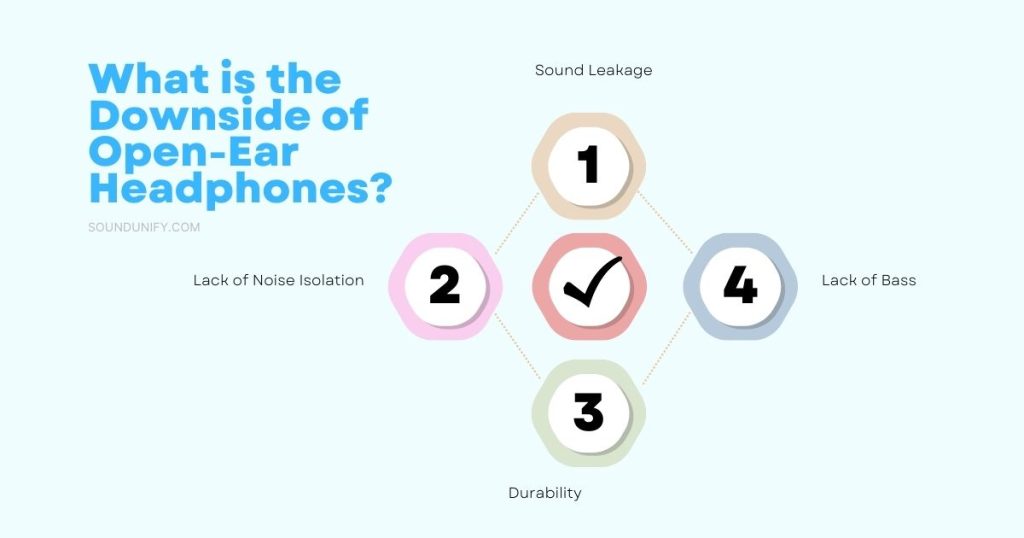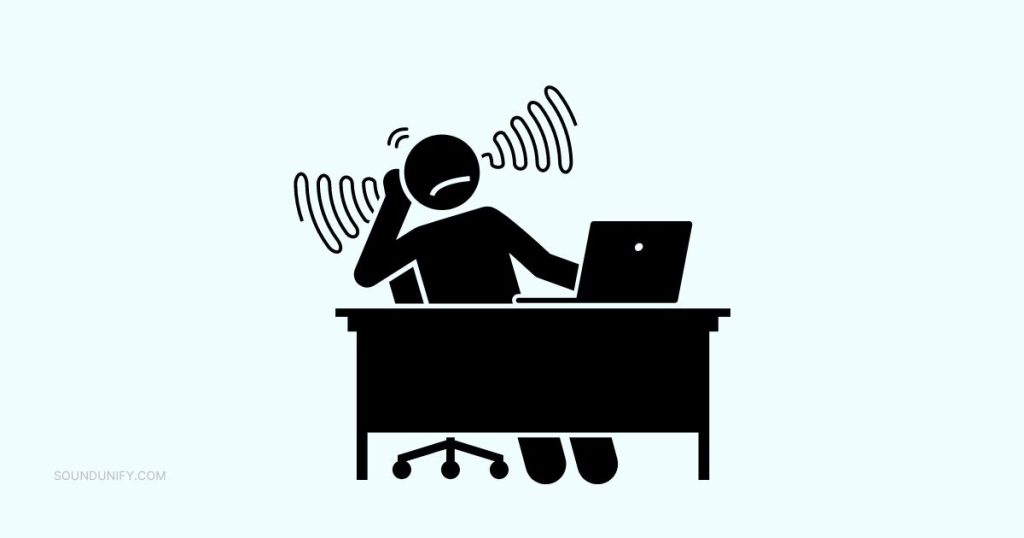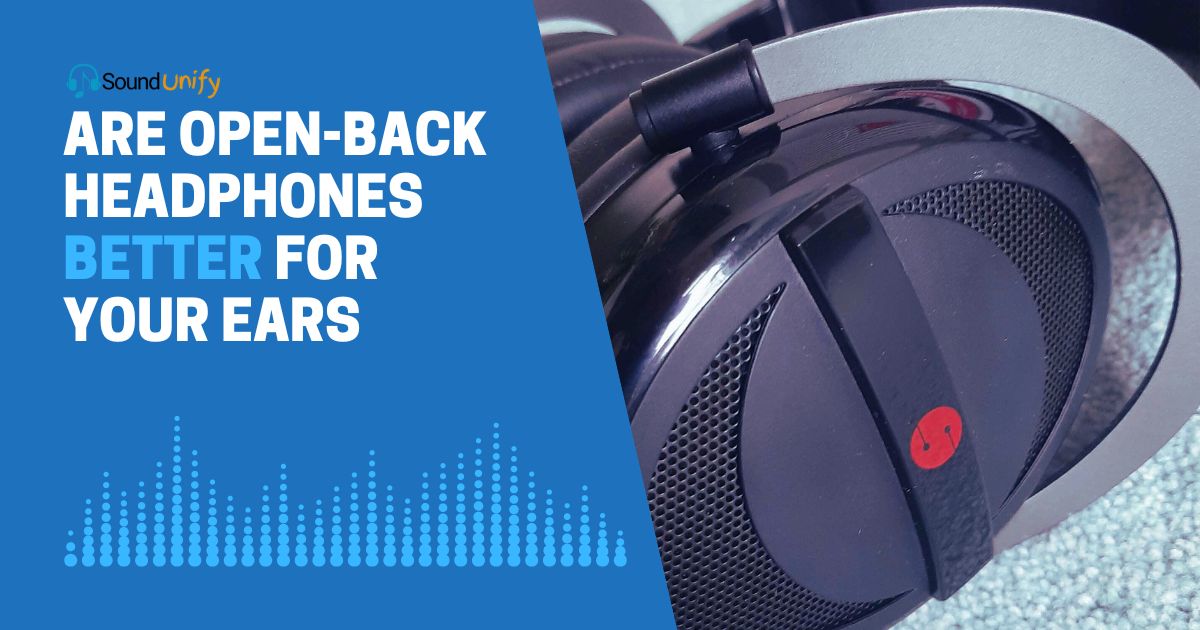Yes, open-back headphones are generally considered better for your ears. Their design reduces the intensity of the sound sent, making them safer for long-term use.
I’ve always been a music enthusiast and have tried countless headphones. But nothing compares to the first time I slipped on a pair of open-back headphones.
The sound, oh, the sound! It was like stepping into a live concert. But I also noticed something else – my ears felt less tired.
You see, traditional closed-back headphones can cause problems. They trap sound, creating pressure that can damage hearing over time. Plus, they don’t deliver that authentic, immersive sound experience we crave.
But don’t just take my word for it. Stick around as we explore why open-back headphones are better for your ears. Also, discuss why they might not be the best for your ears. Trust me; you’ll want to hear this.

Understanding Ears in the Context of Open-Back Headphones
Our ears are complex organs, each with three main parts:
- The Outer Ear (Pinna) is the visible part of the ear that captures sound waves and funnels them into the ear canal.
- The Middle Ear, which contains the eardrum and three tiny bones called ossicles, amplifies the sound waves.
- The Inner Ear (Cochlea) converts the sound waves into electrical signals that our brains can interpret.
There are a few key points regarding the interaction between our ears and open-back headphones. The open design of these headphones allows sound waves to escape, creating a more natural and spacious sound experience.
Additionally, they provide better air circulation around the ears. This makes them more comfortable for long periods.
From a health perspective, one of the most important factors is our exposure to loud sounds. Prolonged exposure to high sound pressure levels can lead to hearing damage.
Open-back headphones typically produce lower sound pressure levels than closed-back headphones, potentially reducing the risk of hearing damage.
| Feature | Open Back Headphones | Closed Back Headphones |
|---|---|---|
| Sound Experience | More natural and spacious | More isolated and direct |
| Air Circulation | Better, less heat around the ears | Less can cause more heat |
| Sound Pressure Levels | Typically lower | Typically higher |
15 Reasons Why Open-Back Headphones Better for Your Ears
1. Natural Sound
Open-back headphones are renowned for their ability to deliver a more natural sound. This is mainly due to their design, which allows air to circulate freely through the ear cups. This minimizes echo and distortion that can occur with closed-back models.
- Air Flow: The design of open-back headphones promotes air circulation, reducing echo and leading to a more natural sound.
- Sound Quality: The sound produced by open-back headphones is often described as “open” or “airy,” a characteristic highly valued by audiophiles and music enthusiasts.
- Sound Reflection: Unlike closed-back headphones, open-back models don’t reflect sound back towards your ears, which can cause distortion. This results in a cleaner, more natural listening experience.
| Headphone Type | Sound Quality |
|---|---|
| Open-back | Natural, airy |
| Closed-back | It can have an echo effect |
2. Better Soundstage
Open-back headphones are known for providing a wider soundstage compared to their closed-back counterparts. This creates a more immersive listening experience, making you feel like you’re in the middle of the performance.
- Spatial Perception: Open-back headphones allow sound to interact with the environment, creating a sense of space and depth. That’s akin to being in the same room as the musicians.
- Music Genres: Genres like live recordings or orchestral music sound more realistic and immersive on open-back headphones.
- Directional Cues: Open-back headphones are better at providing a sense of direction in the sound. This makes it easier to pinpoint where each instrument or voice is coming from.
3. Accurate Sound Reproduction
Open-back headphones are often the go-to choice for professionals and audiophiles due to their accurate sound reproduction.
They allow sound waves to escape. It prevents the build-up of specific frequencies, resulting in a more balanced sound.
- Frequency Balance: Open-back headphones typically have a more balanced response. This means no particular frequency (bass, mid, treble) is overly emphasized.
- Professional Use: Sound engineers and music producers often prefer open-back headphones for mixing and mastering due to their accuracy.
- Sound Distortion: Open-back headphones are less likely to distort sound, as they don’t trap sound waves within the ear cups.
4. Prevents Sound Pressure Build-Up
Open-back headphones can prevent the build-up of sound pressure, which can harm your ears over time.
- Sound Pressure: Closed-back headphones can cause pressure to build up against your ears, which isn’t an issue with open-back headphones.
- Hearing Health: Prolonged exposure to high sound pressure levels can potentially damage your hearing. Open-back headphones mitigate this risk by allowing sound to escape.
- Ear Comfort: The reduced sound pressure also means your ears are less likely to feel discomfort during long listening sessions.
5. Less Fatigue
Open-back headphones can lead to less listening fatigue. Their open design allows for better heat dissipation, making them more comfortable to wear for extended periods.
- Heat Dissipation: Closed-back headphones can cause your ears to become warm or even sweaty after prolonged use. Open-back headphones, with their better air circulation, mitigate this issue.
- Comfort: The increased comfort provided by open-back headphones can make for a more enjoyable listening experience, especially during long listening sessions.
- Long-term Use: If you plan on using headphones for extended periods, open-back headphones can be a more comfortable and healthier choice.
6. Long-Term Comfort
Open-back headphones are often praised for their long-term comfort. Open-back headphones provide a more relaxed fit than closed-back headphones. That can feel claustrophobic after extended use.
- Breathability: The design of open-back headphones allows for better air circulation. You reduce the likelihood of your ears becoming hot and uncomfortable during long listening sessions.
- Weight: Open-back headphones are often lighter than closed-back models. That can reduce strain on your head and neck during prolonged use.
- Pressure: The open design also means less stress on your ears, which can lead to increased comfort over time.
7. Reduced Heat
One of the critical advantages of open-back headphones is their ability to reduce heat build-up. This is particularly beneficial during long listening sessions or in warmer environments.
- Air Circulation: The open design allows air to circulate freely, helping to keep your ears cool.
- Comfort: Reduced heat build-up can lead to a more comfortable listening experience.
- Sweat Reduction: By allowing heat to escape, open-back headphones can also help to reduce sweating, which can be a common issue with closed-back models.
8. Ideal for Quiet Environments
Open-back headphones are ideal for use in quiet environments. Because they allow sound to escape, they can provide a more immersive and natural listening experience.
- Natural Sound: The open design allows sound to interact with your environment, creating a more realistic soundstage.
- Disturbance: Remember that this also means they can disturb others in your vicinity if the volume is high. Therefore, they’re best used in a quiet, private setting.
- Awareness: Open-back headphones also allow you to maintain awareness of your surroundings, which can be beneficial for safety reasons.
9. Reduced Risk of Hearing Damage
Open-back headphones can potentially reduce the risk of hearing damage. This is because they allow sound to escape, preventing the build-up of sound pressure that can occur with closed-back models.
- Sound Pressure: High proper pressure levels can damage your hearing over time. Open-back headphones mitigate this risk by allowing sound to escape.
- Volume Levels: Listening at safe volume levels is still important, even with open-back headphones. Prolonged exposure to loud music can still lead to hearing damage.
10. Ideal for Mixing and Mastering
Open-back headphones are often the preferred choice for professionals involved in mixing and mastering. This is due to their accurate sound reproduction and wide soundstage.
- Sound Accuracy: Open-back headphones are known for their balanced and accurate sound, which is crucial for professionals who need to hear every detail of the music.
- Soundstage: The wide soundstage provided by open-back headphones can make it easier to pinpoint the location of different instruments in the mix.
- Professional Use: Many sound engineers and music producers prefer open-back headphones due to these advantages.
11. Better for Classical Music
Open-back headphones are often the preferred choice for listening to classical music. This genre usually involves complex arrangements and a wide range of instruments.
That can be better appreciated with the natural sound and wide soundstage provided by open-back headphones.
- Instrument Separation: Open-back headphones can provide better instrument separation. It allows you to appreciate the complexity of classical compositions.
- Natural Sound: The natural, airy sound produced by open-back headphones can enhance the listening experience, making it feel like you’re in a concert hall.
- Dynamic Range: Classical music often has a wide dynamic range, from very soft to loud. Open-back headphones can handle these changes in volume more accurately.
12. Better for Jazz Music
With its intricate melodies and improvisations, jazz music can benefit from the natural sound and wide soundstage of open-back headphones.
- Detail Retrieval: Open-back headphones can help bring out the subtle details in jazz music, from a saxophonist’s breath to a cymbal’s brush.
- Immersive Experience: The wide soundstage can make it feel like you’re in a jazz club, providing a more immersive listening experience.
- Instrumental Clarity: The clear, balanced sound of open-back headphones can help highlight the individual instruments in a jazz ensemble.
13. Better for Recording
Open-back headphones are often used in recording studios due to their accurate sound reproduction. They allow sound engineers to hear the music as it is, without any coloration or distortion.
- Sound Accuracy: Open-back headphones provide a more accurate representation of the sound, which is crucial during the recording process.
- Mixing and Mastering: They’re also often used in mixing and mastering, where it’s crucial to hear every music detail.
- Avoiding Microphone Bleed: Remember that open-back headphones can leak sound, which microphones can pick up during recording. They’re best used during the mixing and mastering stages rather than during the actual recording.
14. Better for Acoustic Music
Acoustic music can significantly benefit from the natural sound and wide soundstage of open-back headphones. The nuances of acoustic instruments and vocals can be better appreciated with these headphones.
- Natural Sound: The natural sound of open-back headphones can enhance the nuances of acoustic music, making it feel like the musicians are in the same room as you.
- Instrumental Details: They can help bring out the subtle details of acoustic instruments, from a guitar’s strumming to a cello’s resonance.
- Vocal Clarity: Open-back headphones can also provide more precise, natural-sounding vocals, often an essential element of acoustic music.
15. Increased Awareness of Surroundings
One of the benefits of open-back headphones is that they allow you to maintain some awareness of your surroundings. This can be beneficial for safety reasons or if you must know what’s happening around you.
- Safety: If you’re walking or cycling, open-back headphones can let you hear traffic and other important sounds.
- Awareness: Even when immersed in your music, you can still be aware of your surroundings, which can be helpful in various situations.
- Balance: Open-back headphones provide a balance between immersing yourself in your music and staying connected to the world around you.
What Is the Downside of Open-Ear Headphones?

While open-back headphones offer numerous advantages, they also have some downsides that are important to consider. Here are some of the main ones:
1. Sound Leakage
One of the most significant downsides of open-back headphones is that they leak sound. This means that people around you can hear what you’re listening to, and you can hear ambient noise from your surroundings.
- Privacy: If you’re listening to something you’d prefer others not to hear, open-back headphones might not be the best choice.
- Disturbance: If you’re in a quiet environment like a library or an office, the sound leakage could disturb people around you.
2. Lack of Noise Isolation
Open-back headphones don’t isolate noise as effectively as closed-back headphones. They’re not the best choice for noisy environments, as you can hear background noise.
- Noise Interference: The noise can interfere with your music in a noisy environment, such as a busy street or a crowded bus.
- Volume Levels: You might be tempted to turn up the volume to drown out the background noise, which can potentially damage your hearing.
3. Durability
Open-back headphones are generally more delicate than closed-back headphones. They have exposed components that could be damaged by dust or moisture.
- Care: You’ll need extra care to prevent damage when handling and storing open-back headphones.
- Environment: They’re not the best choice for outdoor use or in environments where they could be exposed to dust or moisture.
4. Lack of Bass
Some users find that open-back headphones lack the deep, punchy bass that closed-back headphones can provide. The open design allows low-frequency sounds (like bass) to escape.
- Music Genres: If you listen to a lot of music with heavy basses, such as hip-hop or electronic music, you might find the bass lacking in open-back headphones.
- Sound Preference: This primarily comes down to personal preference. Some people prefer the more natural, balanced sound of open-back headphones, while others prefer the enhanced bass of closed-back headphones.
Can You Hear More with Open-Back Headphones?
Yes, with open-back headphones, you can hear more compared to closed-back headphones.
As an open-back headphone user, I’ve noticed that these headphones allow more environmental sounds to reach my ears due to their design. The ear cups on open-back headphones are not completely sealed, which means sound can pass freely in and out.
This design creates a more natural and spacious soundstage, making it feel like the music comes from all around you rather than directly from the headphones.
However, this also means that ambient noise from your surroundings can interfere with your music. If you’re in a noisy environment, you’ll be able to hear more of that background noise.
Similarly, people around you can hear what you’re listening to because sound leaks out of the headphones.
So, while open-back headphones can provide a more immersive and natural listening experience, they’re best used in quiet environments where ambient noise won’t be an issue.
Are Open-Ear Headphones Better for Tinnitus?

As someone who has researched and written about headphones, I can tell you that the relationship between open-back headphones and tinnitus isn’t straightforward.
Tinnitus is characterized by a ringing or buzzing noise in the ears. Many factors can influence this, and the type of headphones you use is just one of them.
Open-back headphones could potentially be better for tinnitus sufferers in some respects. They tend to produce a more natural sound and prevent the build-up of sound pressure, which could exacerbate tinnitus symptoms.
They also allow some ambient noise to enter, which can help mask some people’s tinnitus sounds.
It’s important to note that listening to music at high volumes, regardless of the type of headphones you use, can worsen tinnitus. Therefore, if you have tinnitus, keeping the volume safe and taking regular breaks from headphones to rest your ears is crucial.
Ultimately, whether open-back headphones are better for tinnitus can depend on the individual. Some people might find them more comfortable and beneficial, while others might not notice a difference.
If you have tinnitus and are considering changing your headphones, it might be worth discussing this with a healthcare professional or an audiologist.
FAQs
What are the benefits of open-ear headphones?
Open-ear headphones allow your music to interact with the room around you, leaving your hearing unobstructed. They are also more comfortable as your ears aren’t enclosed in a tiny box.
Why do people prefer open-back headphones?
People prefer open-back headphones because they provide a more natural and immersive sound experience. They also allow audio leakage out of the earpieces, making you more aware of your external surroundings.
Are open headphones better for avoiding pressure in the ears?
Yes, open headphones can help avoid pressure build-up in the ears, leading to discomfort and potential hearing damage over time.
Do open-back headphones help with tinnitus?
While open-back headphones can’t cure tinnitus, they can help manage it by providing a more natural sound experience and reducing pressure on the ears.
Final Thoughts
In my opinion, open-back headphones can be better for your ears in several ways. They provide a more natural sound, prevent sound pressure build-up, and can lead to less listening fatigue due to their design.
They’re best used in quiet environments due to sound leakage and lack of noise isolation. It’s also crucial to remember that regardless of the type of headphones, listening at safe volume levels is critical to protecting your hearing.
Always consider your personal needs and environment when choosing headphones.
James Dimento is a Chief-in-Editor of SoundUnify. He is a headphone enthusiast and creative writer passionate about audio technology. He has three years of experience writing about headphones and sound quality and is responsible for creating reviews and taking care of all administration.
